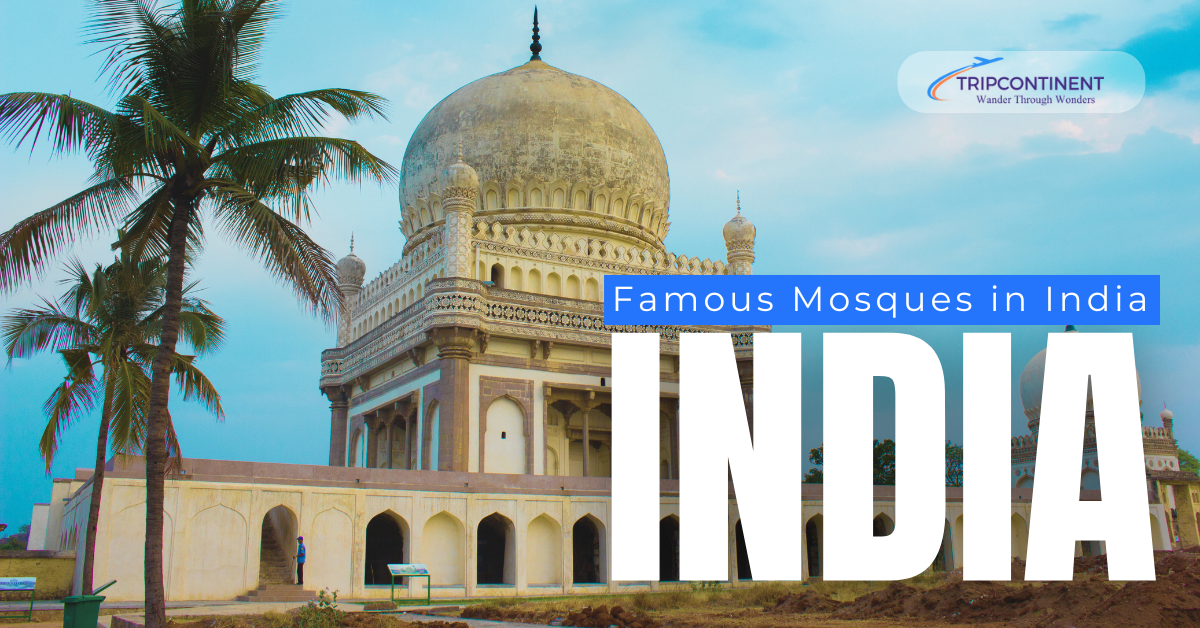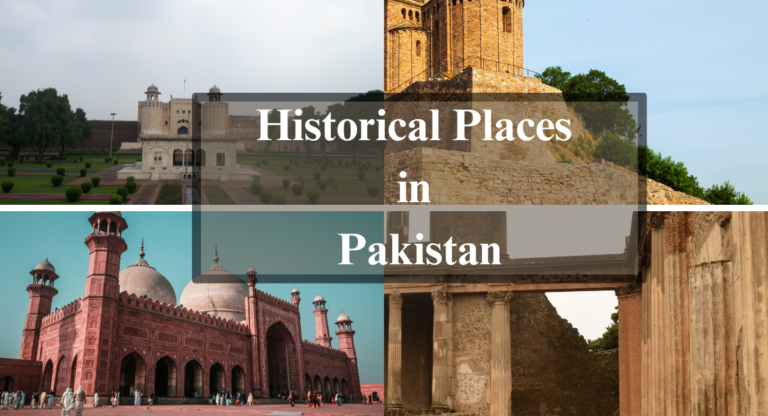Exploring the 12 Most Famous Mosques in India in 2024
India is home to many cultures and religions, and its rich Islamic heritage is beautifully reflected in the numerous mosques scattered across the country. From grand architectural marvels to serene, historic sites, these mosques not only serve as places of worship but also as symbols of India’s rich culture and history.
The mosques of India stand out for their architectural splendor and historical significance, showcasing a variety of styles influenced by the Mughal Empire, regional dynasties, and local traditions. Each mosque tells a story of the bygone eras and the artistic excellence of the period in which it was built.
These mosques not only serve as spiritual centers but also attract visitors from around the world.
List of the Famous Mosques in India
Following is the list of the Famous Mosques in India.
- Jama Masjid, Delhi
- Makkah Masjid, Hyderabad
- Jama Masjid, Ajmer
- Taj-ul Masjid, Bhopal
- Bara Imambara, Lucknow
- Adhai Din ka Jhonpra Mosque, Ajmer
- Moti Masjid, Agra
- Jamali-Kamali Mosque, Delhi
- Nagina Masjid, Agra
- Quwwat-ul-Islam Mosque, Delhi
- Hazratbal Masjid, Jammu & Kashmir
- Jamia Masjid, Srinagar
1. Jama Masjid, Delhi
The Jama Masjid in Delhi is one of the largest and most renowned mosques in India, located in the heart of Old Delhi. Built between 1644 and 1656 by the Mughal Emperor Shah Jahan, it is a testament to Mughal architecture and grandeur, designed by Ustad Khalil. The mosque is also called Masjid-i-Jahan-Numa, meaning “World-Reflecting Mosque.”
Constructed with red sandstone and white marble, the mosque covers an area of about 1,200 square meters and can accommodate 25,000 worshippers at a time in its large courtyard. The mosque has three majestic domes, two towering minarets (40 meters high), and four smaller minarets. The domes are made of marble, while the minarets have alternating vertical strips of white marble and red sandstone.
Historically, Jama Masjid was not only a religious center but also played a significant role in the community as a place for public gatherings and political announcements during the Mughal era.
Today, the Jama Masjid is a popular tourist attraction and remains an active place of worship. It serves as a central hub for Friday prayers, with people from all walks of life coming together to offer prayers. Visitors are required to dress modestly, and non-Muslims can visit outside of prayer times.
Also read: Largest Empires in History
2. Makkah Masjid, Hyderabad
The Makkah Masjid in Hyderabad is one of the oldest and largest mosques in India. Located near the historic Charminar, it holds great significance for the Muslim community. The construction of this grand mosque began in 1617 during the reign of Sultan Muhammad Qutb Shah, the fifth ruler of the Qutb Shahi dynasty, and was completed in 1694 by Mughal Emperor Aurangzeb.
The mosque derives its name from the city of Mecca because the central arch is said to be made from bricks crafted from soil brought from Mecca. The mosque can accommodate up to 20,000 worshippers at a time, making it one of the largest mosques in India. The structure is built predominantly from granite, and the massive hall measures 75 feet high, 220 feet wide, and 180 feet long. Fifteen arches support the mosque’s roof, five each on three sides.
One of the mosque’s unique features is the presence of a hair relic of Prophet Muhammad (PBUH) stored in the mosque. The courtyard also has a large pond, and along the edges of the complex are marble graves of the Asaf Jahi rulers, adding historical significance.
The Makkah Masjid remains a significant religious and historical monument, attracting thousands of visitors and worshippers, especially during festivals like Eid.
3. Jama Masjid, Ajmer
The Jama Masjid in Ajmer, Rajasthan, is an important historical mosque built by the Mughal Emperor Shah Jahan in 1638. Located near the famous Ajmer Sharif Dargah, it reflects Mughal architectural brilliance and serves as a significant place of worship for the local Muslim community.
This mosque was constructed as a token of gratitude by Shah Jahan for his victory in a military campaign. The mosque’s prayer hall is spacious and can accommodate hundreds of worshippers at a time. Though smaller in scale compared to other grand Mughal mosques, the Ajmer Jama Masjid still stands out for its elegant design and historical value.
The mosque features a rectangular courtyard and is built primarily from white marble, giving it a serene appearance. The main prayer hall is adorned with intricate calligraphy and floral motifs, typical of Mughal architecture. The walls are inscribed with verses from the Quran, adding a spiritual ambiance to the place.
What makes the Jama Masjid in Ajmer particularly special is its proximity to the Ajmer Sharif Dargah, which is the tomb of Moinuddin Chishti, a revered Sufi saint. This adds to the religious importance of the mosque, as many pilgrims visiting the dargah also stop to pray at the mosque.
4. Taj-ul Masjid, Bhopal
The Taj-ul Masjid in Bhopal, Madhya Pradesh, is one of the largest mosques in India and a stunning example of Islamic architecture. Its name translates to “Crown of Mosques,” and it lives up to this title. The construction of the mosque began in the 19th century under Shah Jahan Begum, the ruler of Bhopal, and was continued by her daughter Sultan Jahan Begum. However, due to financial constraints, the mosque remained incomplete for many years and was finally completed in 1985.
The mosque’s architecture is a blend of Mughal and Afghan styles, with elements that reflect the elegance of Islamic design. The mosque features a pink façade made of red sandstone, topped with two towering minarets, each rising to a height of 206 feet. The three large onion-shaped domes dominate the skyline, making the mosque a prominent landmark in Bhopal.
The prayer hall is expansive and can accommodate thousands of worshippers. The mosque also has a large courtyard and a pond, which adds to the tranquility of the place.
Taj-ul Masjid also serves as a madarsa (Islamic school), where students receive religious education. Despite its late completion, the mosque is one of the largest in Asia and continues to be a major religious and cultural center.
5. Bara Imambara, Lucknow
The Bara Imambara in Lucknow is an iconic historical monument built in 1784 by Nawab Asaf-ud-Daula, the fourth Nawab of Awadh. It was constructed as part of a famine relief program to provide employment to the people of Lucknow during a devastating famine. The name “Bara” means “big,” and “Imambara” refers to a congregation hall for Shia Muslims used during Muharram.
One of the most striking features of the Bara Imambara is its central hall, which is considered one of the largest arched constructions in the world without the support of pillars or beams. The hall is 50 meters long and 15 meters high, showcasing an incredible feat of engineering. The structure is made from Lakhnawi bricks and lime plaster, with no wood or metal used in the construction.
Another unique aspect of the Bara Imambara is the Bhool Bhulaiya, a labyrinth of corridors on the upper floor, designed to confuse intruders. It’s one of the main attractions for visitors, as its complex maze offers a thrilling experience.
The complex also houses a stepwell known as the Baoli, which was used as a water reservoir during that time. The Bara Imambara is a fine example of Mughal architecture mixed with traditional Awadhi design. Unlike many other Mughal buildings, it lacks ornamental embellishments like carvings and painting, yet stands out for its grandeur.
You might also like: Islamic Empires in History
6. Adhai Din ka Jhonpra Mosque, Ajmer
The Adhai Din ka Jhonpra in Ajmer is a historic mosque with a fascinating blend of Islamic and Hindu architectural styles. Originally built as a Sanskrit college during the Chauhan dynasty in the 12th century, it was later converted into a mosque by Sultan Qutb-ud-Din Aibak in 1199 after the conquest of Ajmer. The mosque is named “Adhai Din ka Jhonpra,” which means “shed of two and a half days,” possibly referring to the brief time it took to construct or consecrate the mosque.
The structure is primarily made of yellow sandstone and is an outstanding example of early Indo-Islamic architecture. The mosque features seven arches, with the central arch adorned with intricate Islamic calligraphy.
Despite its conversion into a mosque, the Hindu and Jain influences are evident in the detailed carvings and designs on the pillars and walls. The mosque’s prayer hall is supported by more than 100 pillars, many of which were repurposed from the original Hindu and Jain temple structures.
7. Moti Masjid, Agra
The Moti Masjid in Agra is a beautiful mosque renowned for its exquisite design and historical significance. Constructed by Emperor Shah Jahan in 1654, it is located within the Agra Fort, which was also built during his reign. The mosque’s name, which translates to “Pearl Mosque,” reflects its opulence and the pearly white marble used in its construction.
The Moti Masjid is noted for its simplicity and graceful architecture. The mosque is built entirely from white marble. It features three domes and a spacious prayer hall, which is supported by large, finely crafted pillars. The walls of the mosque are adorned with delicate carvings and inscriptions, enhancing its serene and majestic ambiance.
The mosque’s prayer hall is 30 meters long and 15 meters wide, with a high ceiling and a five-arched façade. The Moti Masjid was designed as a private mosque for the royal family and was intended to be a tranquil place for prayer and reflection.
Unlike many other Mughal mosques, the Moti Masjid lacks extensive decorative elements, emphasizing a minimalist and refined aesthetic.
8. Jamali-Kamali Mosque, Delhi
The Jamali-Kamali Mosque is a historic mosque located in the Mehrauli Archaeological Park in Delhi. Built in 1528, it is notable for its association with two prominent figures: Jamali, a Sufi saint and poet, and Kamali, a fellow mystic and disciple. The mosque’s name combines their names, reflecting its historical and spiritual significance.
Architecturally, the mosque showcases early Mughal design elements. Constructed using red sandstone and white marble, the mosque features a modest yet elegant structure. The central prayer hall is rectangular, with three domes and a series of arched windows that provide a calm and serene atmosphere. The mosque’s façade is adorned with simple geometric patterns and inscriptions from the Quran, which are typical of early Mughal architecture.
One of the mosque’s unique aspects is its twin tombs of Jamali and Kamali, located adjacent to the mosque. These tombs are built in a similar architectural style and are surrounded by intricate tilework and delicate carvings. The tomb of Jamali is particularly notable for its ornate decoration and the inscription of his poetry.
9. Nagina Masjid, Agra
The Nagina Masjid in Agra is a lesser-known but charming historical mosque located within the Agra Fort complex. Built during the Mughal era under Emperor Shah Jahan in the early 17th century, the mosque is named “Nagina,” which means “jewel,” reflecting its delicate and refined design.
The mosque is constructed from white marble, similar to other Mughal structures of the period, which gives it a pristine and elegant appearance. The design is relatively simple but features intricate marble inlays and carvings that highlight the artistry of Mughal architecture.
The prayer hall of the Nagina Masjid is 15 meters long and 12 meters wide, with a central dome and two smaller domes on either side. The interior is adorned with delicate floral patterns and calligraphic inscriptions from the Quran, showcasing the Mughal emphasis on beauty and craftsmanship in religious structures.
Unlike the grander mosques of the Mughal era, the Nagina Masjid was intended for the private use of the royal family, providing a serene and private space for worship within the fort. Its relatively modest size and refined decor make it a gem of Mughal architecture.
10. Quwwat-ul-Islam Mosque, Delhi
The Quwwat-ul-Islam Mosque in Delhi is a significant historical mosque located in the Qutub Complex. It is one of the oldest surviving mosques in India, built in 1193 by Qutb-ud-Din Aibak, the founder of the Delhi Sultanate. The mosque was constructed using materials taken from Hindu and Jain temples, reflecting a blend of Islamic and local architectural styles.
The mosque is renowned for its imposing design and use of red sandstone. Its main prayer hall is supported by 27 columns, many of which were repurposed from previous Hindu and Jain temples. The mosque features a large courtyard and a central prayer hall with a high arched entrance. The interior is relatively simple, with minimal decoration compared to later Mughal mosques.
One of the most striking features of the Quwwat-ul-Islam Mosque is its proximity to the Qutub Minar, a towering 73-meter (240-foot) minaret that was constructed during the same period. The mosque and the minaret together form a part of the Qutub Complex, a UNESCO World Heritage site.
The mosque’s construction marks the beginning of the Islamic architectural style in India, setting the stage for future developments in Mughal architecture.
Also see: Richest Countries In Asia
11. Hazratbal Masjid, Jammu & Kashmir
The Hazratbal Masjid in Jammu and Kashmir is a revered mosque located on the northern shore of the Dal Lake in Srinagar. It is renowned for its spiritual significance and stunning architecture. The mosque’s name, “Hazratbal,” means “Sacred Place” in Persian, reflecting its deep religious importance.
Built in 1694 by Sultan Syed Abdullah, a governor of Kashmir under the Mughal Emperor Aurangzeb, the mosque was constructed to house a relic believed to be a hair strand of the Prophet Muhammad (PBUH). The mosque is constructed from white marble, which adds to its serene and elegant appearance. Its architectural style is a blend of Mughal and Kashmiri designs, characterized by clean lines, minimal ornamentation, and a graceful, domed structure.
The mosque’s main prayer hall is 55 meters long and 25 meters wide, with a central dome rising to 20 meters. It can accommodate several hundred worshippers at a time. The pristine setting of the mosque, overlooking the Dal Lake with the backdrop of the Himalayan mountains, enhances its spiritual and visual appeal.
Throughout history, the Hazratbal Masjid has been a focal point for the local Muslim community and has hosted numerous religious gatherings and events.
12. Jamia Masjid, Srinagar
The Jamia Masjid in Srinagar, Jammu and Kashmir, is a significant historical and architectural landmark. Located in the heart of the old city of Srinagar, this mosque was originally built in 1394 by Sultan Sikandar, a ruler of the Shah Mir dynasty. It was later renovated by Sultan Haidar Shah in 1479. The mosque’s name, “Jamia,” means “Grand Mosque,” reflecting its importance in the region.
The Jamia Masjid is known for its striking wooden architecture, a rarity among mosques in India. The mosque is constructed from deodar wood, featuring 378 wooden pillars that support the roof, which is adorned with intricate carvings and traditional Kashmiri designs. The mosque has a large, open courtyard that can accommodate thousands of worshippers, with a covered prayer hall that extends to a length of 30 meters and a width of 20 meters.
The mosque’s unique feature is its beautiful wooden minarets and its lush, green courtyards, which provide a tranquil environment amidst the bustling city. The Jamia Masjid’s interior is decorated with wooden screens and intricate carvings, showcasing the craftsmanship of Kashmiri artisans.
Conclusion
India’s mosques are not just places of worship but are significant cultural and architectural landmarks that reflect the country’s rich Islamic heritage. They stand as enduring symbols of the diverse and dynamic cultural history of India, inviting both worshippers and tourists to appreciate their beauty and historical significance.
FAQs
Which Is the Most Holiest Mosque?
The holiest mosque in Islam is the Masjid al-Haram in Mecca, Saudi Arabia. It is considered the most sacred mosque in the Islamic faith for several reasons:
- Location of the Kaaba: The Masjid al-Haram surrounds the Kaaba, the most sacred site in Islam. Muslims around the world face the Kaaba during their daily prayers, and it is the focal point of the annual pilgrimage known as Hajj.
- Hajj and Umrah: The mosque is the central location for the pilgrimage of Hajj, one of the Five Pillars of Islam, which every Muslim is required to perform at least once in their lifetime if they are able. It is also the site for Umrah, a pilgrimage that can be undertaken at any time of the year.
- Religious Significance: The mosque’s sanctity is rooted in its historical and spiritual significance, including its role in the early life of the Prophet Muhammad (PBUH) and the continuous tradition of worship at the site.
What Is the Oldest Mosque on Earth?
The Quba Mosque in Medina, Saudi Arabia, is considered the oldest mosque in the world. The Quba Mosque was the first mosque built by the Prophet Muhammad (PBUH) and his companions after their migration (Hijra) from Mecca to Medina in 622 CE. Its construction marks the beginning of the establishment of the Muslim community in Medina.
How Old Is Kaaba?
The Kaaba in Mecca, Saudi Arabia, is considered one of the oldest religious structures in the world. According to Islamic tradition, the Kaaba was originally built by the Prophet Ibrahim (Abraham) and his son Isma’il (Ishmael). The exact date of this construction is not definitively known, but it is believed to date back several thousand years, around 2000 BCE.
What Is the Biggest Mosque in the World?
The Great Mosque of Mecca, also known as Masjid al-Haram, is the largest mosque in the world. The mosque covers an area of approximately 356,800 square meters (about 88 acres). The mosque can accommodate up to 2 million worshippers during the Hajj pilgrimage.
Which Masjid Was the First Qibla?
The first Qibla in Islam was the Al-Aqsa Mosque in Jerusalem. Initially, Muslims were commanded to face the Al-Aqsa Mosque during prayers, a practice that continued for about 16 to 17 months after the beginning of Prophet Muhammad’s (PBUH) mission.

I’m Sophia Jones, an adventurer at heart from New York City, USA. I live for travel and exploration, always eager to discover new places, meet fascinating people, and try out diverse cuisines. Over the past few years, I’ve traveled to numerous countries, immersing myself in different cultures and creating unforgettable memories.






